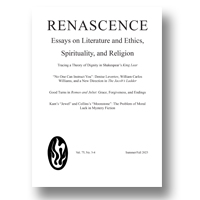|
3.
|
Renascence:
Volume >
68 >
Issue: 3
G. J. Bednar
From Emptiness to Hunger:
Lonergan, Lynch, and Conversion in the Works of Flannery O’Connor
abstract |
view |
rights & permissions
| cited by
Bernard Lonergan, SJ, has noted that an empty box does not know it is empty and does not care whether it is empty or full. An empty stomach, on the other hand, knows when it is empty and yearns for what will satisfy it. Flannery O’Connor’s stories present the reader with a parade of characters who are empty boxes in the process of becoming empty stomachs. William Lynch, SJ, said that many times such conversions result from stark encounters with the finite, thus accounting for the grotesque in O’Connor’s stories.
|
|
|
4.
|
Renascence:
Volume >
68 >
Issue: 3
Molly Robinson Kelly
Reading Oscar Wilde’s Spirituality in De Profundis
abstract |
view |
rights & permissions
| cited by
The article offers a new reading of the central portion of Wilde's famous prison letter, which I call the letter's "spiritual center." In this central section, Wilde contemplates his future and expresses his desire to start a new life, a Vita nuova. As he works to envision in writing a future that can integrate the suffering of his prison experience, he outlines a spiritual vision that is both startlingly original, and informed by varied religious traditions, including Buddhism, Taoism, and the British Occultist movement. In this article, I provide a careful reading of the four tasks Wilde sets out for himself to serve as the foundation for his Vita nuova. In order to better understand the context for Wilde's spiritual writing, I also explore briefly the religious and spiritual influences of the author's life. I conclude with a consideration of the values which underlie Wilde's four tasks, and the spiritual portion of his letter in general; namely, individual self-realization, suffering, and acceptance. Taken together, my article's contextual study and attentive reading of De Profundis's spiritual center offer a new understanding of both Wilde's practical spirituality and the spiritual milieu of the fin-de-siècle.
|
|
|
5.
|
Renascence:
Volume >
68 >
Issue: 3
Paul A. Lacey
“So Rich a Consciousness of Time”:
A Meditation from Professor Lacey
abstract |
view |
rights & permissions
| cited by
Paul A. Lacey’s rich meditation on the importance of reading and re-reading offers sage perspective on Henry James’s The Ambassadors and The Portrait of a Lady. Waxing wise on W. B. Yeats, James Joyce, and A. E. Housman, Lacey’s essay provides a reason not to lose touch with the works we love to read and re-read.
|
|
